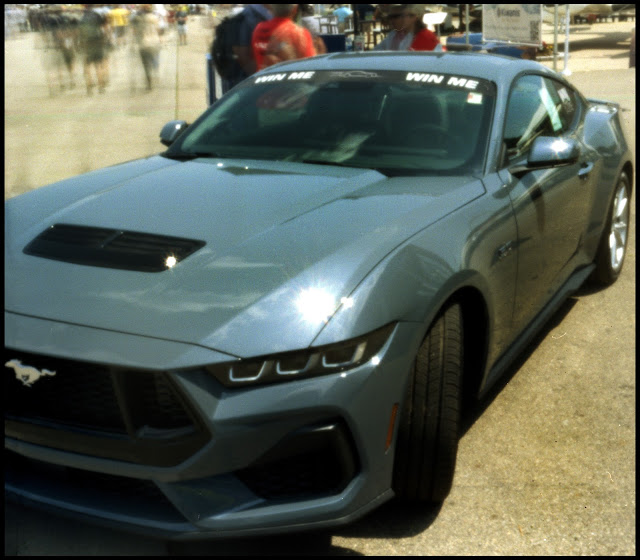I chose to use black and white film for the EAA AirVenture for the last two years. In order to allay my worries about the same old thing, this year I used color film. For shorter exposure times in shady situations, despite the risk of overexposure in the sun, Kodak Portra 800 went into all three cameras: The EyePA, 30mm at 90 degrees, The Little Mutant, 45mm at 67 degrees, and Goldberry, 80mm at 41 degrees.
It's also pretty obvious that airplane owners aren't exactly afraid of color.
I arrived quite early so the line to see the cockpit in the giant C17 Globemaster was only about halfway out of the cargo bay. The gentleman in front of me had spent his career with Boeing and had worked on 120 of these airplanes. He pointed to the parts as he listed them although none were visible from inside the plane. He explained that what looked like rust was a special composite used for molded ventilation junctions. It didn't affect how it worked so they just left it that way.
The captain was greeting visitors. She asked me what kind of device the box on the tripod was. "At EAA," I replied, "you'd probably call it a homebuilt."
A Pratt and Whitney 18 Cylinder Double Wasp on a shiny red biplane
Another biplane with speedy red livery.
The Ohio-based owner of this aircraft is always surprised because everyone assumes he's from Wisconsin.
Partially finished fuselages are common in the homebuilt displays to show the structure and how the flight control surfaces are connected.
Lots of ways and materials to do this with but it basically all involves triangles.
Awaiting the engine to be installed with the front cowling and the form used to make it.
This Lycoming engine is intended to go into that cowling.
One of those engines installed inside a VariEze with the propellor shaft attached.
In the gas welding workshop.
A colorfully striped delta winged homebuilt.
A homebuilt ultralight with the most primitive flight control possible and all the latest high tech avionics.
This little homebuilt jet was one of the first of it's kind in the 1980's and is famous for crashing and being restored to flying condition twice.
A seaplane being converted to electric power for a harbor taxi company in Maine.

This year's raffle prize for The Young Eagles trying to get me to buy a ticket with a friendly smile and "win me" eyebrows.
As I was setting up for that photograph, a gentleman who seemed about my age (OK, as
old) told me I had a pinhole camera. He knew what it was and how it worked but he had never seen anyone with one. He said I should take a pinhole photograph of "Fifi," the WWII B-29 Bomber he flies for the happily renamed
Commemorative Air Force, which maintains historic aircraft in flying condition. I went and did it but it was too late when the thought occured to me of telling him that I'd do it if he'd get me into the cockpit. An hour long flight in that front seat costs two grand.

Camping next to your airplane about 50 yards from a very busy runway is very popular. The airport is closed to flights from 8 pm until 7 am. Some campsites are better equipped than others.

Some things have to do double duty.
Is there a technical term for this equipment?
A shiny Beechcraft 18.
A comfortable place to sit and rest in the shade can be hard to find, but the Theatre in the Woods usually has lots available. Just movies at night this year but it has seen a gathering of 10 of the 12 Apollo Moonwalkers and the occasional rock band like REO Speedwagon and the Beach Boys.
The cockpit of a Cirrus VisionJet. If your pilot "becomes disabled" you can pull a lever and the plane lands itself.
Another Lycoming engine, this time in some golden finish.
A rotary engine for ultralights.
I think aliens might have taken over Junkers Aircraft.
The landing gear of that Junkers A50 Junior.
The exhibitor's hangars display everything aeronautical possible from custom interiors for your private jet to these used cockpit instruments.
Seeing the tent from a distance, I wondered what "Flying Eyes" were. The young woman behind these shades "designed to fit with any helmet or headgear" didn't seem surprised when I told her the booth was a great subject for color film. She agreed, went just to the left and pointed me out to her colleague but never said anything about the cardboard camera.
In the NASA tent, the group trying to develop a safe air taxi system were displaying their work on Virtual Reality headsets. It was funny watching people moving their heads around to look at the displays and leaning over to look down at the ground below. I found myself doing exactly the same thing when it was my turn.

The flight simulation chair shown by the Graphics and Visualization Lab that I experienced two years ago.
In addition to a large collection of motorcycles, cars and lawn-care equipment, Honda again had their jet on display, inside a tent with lighting all the way around the plane.
The busiest air traffic control tower in the world for a week.
The EyePA 30mm has .23mm pinholes on the axis and 11mm above it. The Little Mutant 45mm has .27mm pinholes on the axis and 10mm above it. Goldberry has a .32mm pinhole 80mm from the film. All three have 6x6cm frames and nothing but air between subject and film. The Kodak Portra 800 was developed in an Arista.edu Liquid Quart C41 kit.



































No comments:
Post a Comment